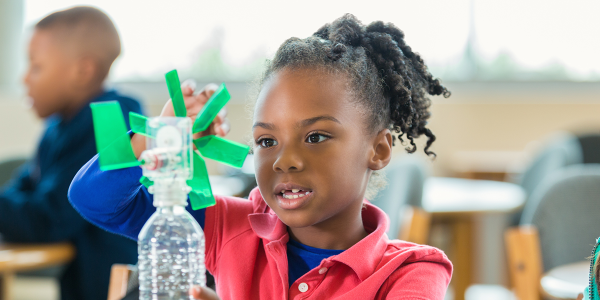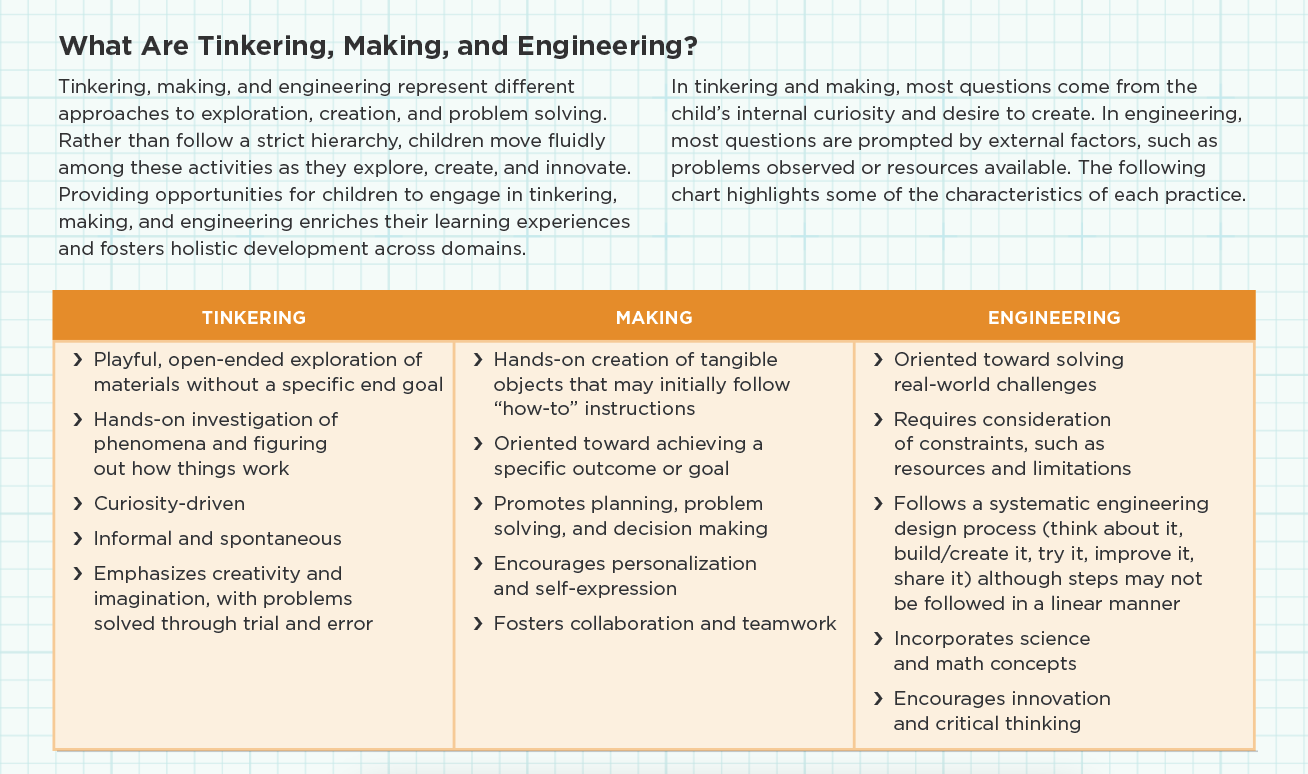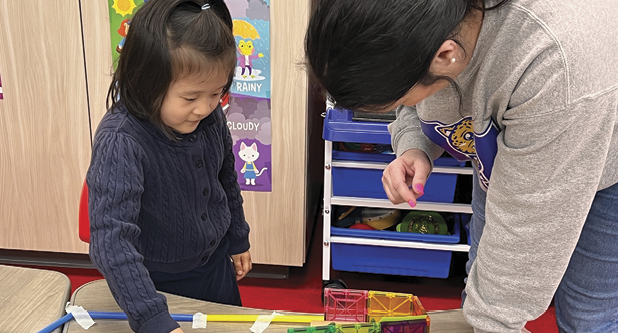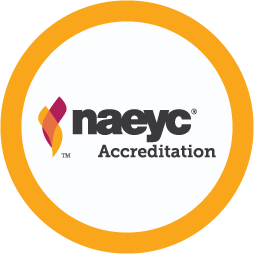Small Hands, Big Ideas: Exploring STEM Through Tinkering, Making, and Engineering

You are here
Ms. Garcia finds a battery-operated plush dog at a garage sale and decides to use it in a take-apart activity with her kindergartners. In small groups, the children closely observe the dog. As Ms. Garcia takes notes, the children dictate everything they notice. They learn that they can make the dog bark by pushing its head back and forth. They feel the dog, guess what they might find inside, and draw their predictions.
During their investigations, one child feels a spring in the tail. Another child thinks there might be a battery in the leg. The children use scissors to remove the dog’s fur. There are squeals of excitement as they confirm their predictions: “Look, I was right! There is a spring in the tail!” After they remove the fur, they turn on the switch to watch the dog move again.
At the base of the dog’s head, the children discover a small, wedge-shaped part that is covered with tissue paper and has a small cone attached to it. It’s the piece that causes the dog to bark. The children cut the tissue paper covering the wedge and discover that the dog no longer barks when they push its head. Much time is spent investigating this tiny piece, and the children decide that the air pushed out of the cone made the barking sound. To test their hypothesis, they cover the piece with some tissue paper and tape, and the dog barks again! The children continue using small screwdrivers to remove the plastic from the dog and discover a small motor and gears.
Children use their senses to explore the physical properties of materials. They tinker as they take things apart, put things together, figure out how things work, and attempt to build and make creations using tools. When faced with a problem, children ask questions, make plans, work together, test their ideas, solve problems, improve their ideas to make them better, and share their ideas and creations with others. These are the thinking processes and actions that scientists and engineers use.
Tinkering, making, and engineering are valuable experiences in early science, technology, engineering, and math (STEM) education. (See “What Are Tinkering, Making, and Engineering?” below for further definitions.) When children tinker, they learn about the properties of materials and the capabilities of tools. The skills and dispositions they learn and acquire during tinkering and making become an important part of the engineering design process.
As we start on this special, two-issue journey exploring STEM education for preschool and kindergarten learners, we’ll explore the world of tinkering, making, and engineering. Leveraging my background as a former preschool and kindergarten teacher, author of curriculum and assessment materials, and author of NAEYC’s Making and Tinkering with STEM: Solving Design Challenges with Young Children, I will share practical insights and strategies to enhance your teaching practice. You will learn about the fundamentals of STEM education, innovative teaching strategies, and actionable ideas you can implement in your early learning setting right away.
Planning for Tinkering, Making, and Engineering: The Teacher’s Role
Tinkering is an important element of the maker movement that is sweeping the country in schools, libraries, makerspaces, and museums. This movement is driven by people’s desires to create something with their hands. The concept is certainly not new to early childhood: children who engage in open-ended tinkering and making experiences practice skills they will use throughout their lives.
The end product of tinkering and making experiences is not as important as the process. Rather, the ultimate goal is to help children think creatively, take risks, and solve problems. For example, when children take things apart (often using child-size tools like screwdrivers and pliers), they see how individual parts work together. They also gain insights into how to put components together in ways that create something new. As children grow and mature, their ability to use tools, collaborate with others, experiment, observe, make discoveries, tap into prior knowledge, communicate, and persevere continues to develop and flourish.
Educators can help young children develop these mindsets in several ways. These include
- asking questions: “How can you make the shadow bigger or smaller? I wonder if all shadows are black? How can we find out?”
- formulating plans: “Your idea about building a car is so interesting. Let’s think about the materials and tools you need to create it.”
- making observational drawings: “Let’s draw a picture of the bird’s nest to remember how it looks. We’ll take our drawing back to class and use it to make our own nests. What materials could you use to recreate it?”
- measuring and recording findings: “Your roller went far after it came down the ramp. How many blocks long did it roll? If you make your ramp steeper, how far will it roll?”
- evaluating outcomes: “When you created your marble run, which part did you like best? Which part was most challenging? If you made one again, what would you change or do differently?”

Setting Up the Environment
The learning environment—both in terms of space and materials—is a key component once children begin engaging in tinkering, making, and engineering. Educators need to consider it carefully. Some learning settings are large enough to have a dedicated space for tinkering and making. These areas typically have shelves available for storing and displaying materials and tools. Other settings may only have room for a table that can accommodate one or two children, and teachers may need to rearrange furniture to allow for larger projects and more children.
Children need lots of open-ended materials and loose parts for tinkering, making, and engineering experiences. Educators should organize and display these materials so that children are encouraged to use their imaginations to invent ways to use them. When materials are organized and displayed attractively, children can clearly see the possibilities for using them. They also learn that everything has a place, which makes both finding things and cleaning up easier. Clear plastic containers or baskets placed at children’s eye level are ideal for storing materials.
If a learning setting isn’t large enough to accommodate a dedicated makerspace, educators can store materials in the art or science areas. As teachers observe children working, they can help them locate any materials that aren’t on display but that they may need. It’s also helpful to designate a shelf or other space for “works in progress.” Sometimes a project or activity may take days to complete. It’s important to provide space for these, so children can come back to their ideas and continue refining their work.
Tinkering Trays
One way to present materials is through tinkering trays. These invite children to create and invent, and they promote independence and decision making. The trays can be used for both engineering design challenges and more general tinkering and making activities.
Shallow containers divided into sections—such as a shadow box, drawer, cutlery tray, muffin tin, egg carton, divided turntable, or drawer organizer—are ideal for creating a tinkering tray. Teachers can fill the sections with small, open-ended objects or loose parts for building and creating. When working with small groups of children, they can place the tray in the center of a table so that everyone can see what is available and reach for what they need.
Another approach is to create a materials “buffet” by setting up several tinkering trays or individual containers on a table. Larger materials may be displayed on or beside the table also. As children gather around, teachers can introduce the materials with questions or comments, such as “What do you notice about these materials?”; “How can you combine them to make something new?”; “This is a new tool. Here’s how to use it.” Children can use containers or snack baskets to walk around the materials buffet and gather what they need for their projects. This fosters independence and choice.
When educators introduce tinkering trays, they need to establish some simple rules, such as
- take only what you need
- keep the trays on the table
- let an adult move the tinkering trays
- share materials you’re not using
Teachers can show children that each material has its own special place, and they can demonstrate how to return the materials to their homes, promoting responsibility and resourcefulness.
Preparing for Tinkering, Making, and Engineering
Intentionally planning for tinkering, making, and engineering experiences in preschool and kindergarten is essential to foster holistic development and prepare young learners for future success. By incorporating these activities into the curriculum, teachers can nurture content-specific knowledge and skills, critical thinking, problem solving, creativity, and perseverance while building on children’s natural curiosities and interests. Hands-on STEM experiences cultivate a solid foundation for lifelong engagement with science, technology, engineering, and mathematics.
To integrate STEM into existing curricula, teachers can reflect on their current practices and identify opportunities for integration. This might involve examining the themes, topics, and projects already present and brainstorming ways to incorporate elements of tinkering, making, and engineering. Additionally, teachers can collaborate with colleagues to share ideas, resources, and high-quality practices for integrating STEM into the classroom.
Collecting Materials
Teachers can find most of the materials suggested in this issue in their learning settings. They can also ask for donations from families or local businesses, tap reusable resource centers, or visit garage sales or thrift stores. When asking families to donate, it’s helpful to place a container or bin in a convenient location, where family members can leave items when they come to pick up or drop off their children.
Teachers should be specific about what they want and identify items they cannot accept because of safety or storage concerns. They should also remember that it isn’t necessary to collect all of their materials at once. The key is to start small. Educators can collect the materials they need for a particular design challenge or tinkering and making activity. As children learn to use them, they might incorporate the same materials in a different way during another activity. A collection of materials will grow over time as teachers introduce new tinkering, making, and engineering activities.
Consider Safety
Using real tools is empowering to young children and promotes a sense of independence. However, teachers must ensure safety by clearly teaching children how to use tools safely and by monitoring their use. For example, teachers can establish rules for using a low-temperature glue gun with a protective tip and show children how to place the glue gun in a cookie tin when they aren’t using it. If teachers notice a safety risk, they should point it out and use it as an opportunity to teach safe handling techniques.
Display Creations
Teachers should plan to showcase children’s finished creations, so others can benefit from the learning involved. Sharing projects fosters a sense of community, encourages collaboration, and allows children to celebrate their creativity and problem-solving skills. It also encourages children to talk about the processes they used and to inspire others to make their own creations. Teachers can plan ahead for ways to display children’s work once it’s ready. They can also review past creations to gather valuable insights for planning future activities that will support each child’s ongoing development in STEM concepts and skills.
Conclusion
When teachers actively engage in fostering children’s curiosity, exploration, content knowledge, and problem solving, they’re implementing developmentally appropriate practice. They’re also helping children form the foundation for later STEM success as well as nurturing confident learners who see themselves as capable scientists, mathematicians, technology creators and users, and engineers. By integrating tinkering and making into early childhood education, we ensure that each and every child experiences the joy of discovery, the thrill of playful learning, and the boundless potential of their imaginations.
STEM and DAP Connections
 When viewed through the lens of developmentally appropriate practice (DAP), tinkering, making, and engineering are even more impactful in enriching children’s learning experiences. Consider:
When viewed through the lens of developmentally appropriate practice (DAP), tinkering, making, and engineering are even more impactful in enriching children’s learning experiences. Consider:
- Teachers foster a sense of belonging by creating inclusive environments where each and every child’s unique abilities and interests are valued (create a caring, equitable community of learners). This might involve collaborative projects where children work together, sharing tools and ideas. For example, working as a group to build a miniature cardboard community encourages teamwork and diverse perspectives—characteristics that make both the process and product better.
- Educators can engage families by partnering with them to plan and implement hands-on materials and activities during and beyond the learning day (engage in reciprocal partnerships with families and communities). Family members may share a favorite hobby, expertise, or passion, like sewing or woodworking. Partnerships with local businesses or experts in the community can provide children with different perspectives and occupations that involve tinkering and making, along with access to a range of materials.
- When integrating tinkering, making, and engineering into the curriculum, teachers can observe children’s problem-solving approaches, creativity, and social interactions (observe, document, and assess children’s development and learning). Documenting these experiences through photos, videos, and written records provides valuable insights into children’s progress. When teachers reflect on these observations, they are better prepared to scaffold children’s learning, plan future learning experiences, and provide a gentle nudge or prompt to present a challenging yet achievable goal.
- Teachers can provide materials, supports, and challenges for each and every learner (teach to enhance development and learning). For example, teachers could introduce basic tools like scissors for fine motor development, then progress to child-safe glue guns and woodworking tools. Adaptive devices, like a switch-activated pair of scissors or a big button used to turn on a motor, ensure inclusivity. Hands-on activities also benefit multilingual learners by promoting language acquisition through multimodal materials and supports, active participation, and collaboration.
- Teachers can seamlessly integrate tinkering, making, and engineering activities into existing curriculum by incorporating hands-on opportunities that align with all content areas and domains (plan and implement an engaging curriculum). For example, when learning about pets, children could design and build a pet carrier to transport an animal to a shelter. To do this, they would need to understand the characteristics of animals as living things (science); the elements of a local community and how to navigate it (social studies); and how to gather details from informational texts and use vocabulary words like veterinarian and animal shelter (language and literacy). Intentional planning ensures that tinkering, making, and engineering activities are enjoyable and purposeful in achieving learning goals.
- When educators experience tinkering, making, and engineering experiences as adult learners, it provides them with firsthand insights into creative and problem-solving processes (demonstrate professionalism as an early childhood educator). This enhances their own professional growth and creates meaningful opportunities for authentic modeling, inspiring children to become lifelong learners. It also fosters confidence and a deeper understanding that will help them introduce and guide children through similar experiences. Attending professional development workshops on incorporating STEM into early childhood education can enhance an educator’s ability to provide well-rounded and developmentally appropriate tinkering and making experiences. Participating in online workshops or collaborating with colleagues also supports adult learners. (For more on the benefits of teachers’ own tinkering activities, see “Making Time for Tinkering: A Playful Pathway Toward STEM Learning”.)
Photographs: header image © Getty Images; first image courtesy of the author
Copyright © 2024 by the National Association for the Education of Young Children. See permissions and reprints online at NAEYC.org/resources/permissions.
 This article supports the following NAEYC Early Learning Programs standards and topics
This article supports the following NAEYC Early Learning Programs standards and topics
Standard 3: Teaching
3E: Responding to Children’s Interests and Needs
3G: Using Instruction to Deepen Children’s Understanding and Build Their Skills and Knowledge
Cate Heroman is one of the founders of Knock Knock Children’s Museum in Baton Rouge, Louisiana, renowned for its emphasis on early literacy and early STEAM education. A nationally recognized educator and author of numerous publications, she has been an early childhood educator, state administrator, trainer, facilitator, keynote speaker, and developer of curriculum and assessment materials.
